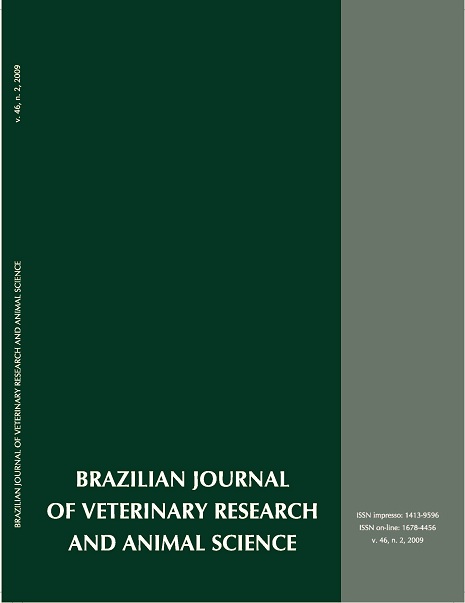Detection of antibodies against Rickettsia rickettsii in equines of the Zoonosis Control Center of São Paulo Municipality (CCZ/SP)
DOI:
https://doi.org/10.11606/issn.1678-4456.bjvras.2009.26753Keywords:
Rickettsia rickettsii, Indirect immunofluorescence assay, Equine, São PauloAbstract
Brazilian Spotter Fever (BSF) is a tick-borne zoonosis transmitted by at least two tick species: Amblyomma cajennense and Amblyomma aureolatum. In areas where the tick vector is A. cajennense, equines are important for being considered primary hosts of this tick species. A. aureolatum, whose primary hosts include birds, some rodent species, and dogs, is incriminated as vector in the metropolitan region of São Paulo city. This work aimed to detect antibodies reactive to Rickettsia rickettsii in equines sent to the Zoonosis Control Center of São Paulo Municipality (CCZ/SP) during the period from 2003 to 2005. After blood collection, sera were obtained by centrifugation and tested by the indirect immunofluorescence assay (IFA) and animals were considered positive if sera presented titers >; 64. During three years, 363 equine sera sent to CCZ/SP, were tested by IFA, and 64 showed reactive: 6 (2003), 16 (2004) and 42 (2005). The end-point titers varied from 64 to 1.024. The results demonstrate a low percentage (17.6%) of reactive animals, when compared with literature data from BSF-endemic areas where A. cajennense is the vector, suggesting that this tick is not a main vector in the study areaDownloads
Download data is not yet available.
Downloads
Published
2009-04-01
Issue
Section
UNDEFINIED
License
The journal content is authorized under the Creative Commons BY-NC-SA license (summary of the license: https://
How to Cite
1.
Moraes-Filho J, Horta MC, Pacheco R de C, Maeda MM, Galano A, Oliveira ML de, et al. Detection of antibodies against Rickettsia rickettsii in equines of the Zoonosis Control Center of São Paulo Municipality (CCZ/SP). Braz. J. Vet. Res. Anim. Sci. [Internet]. 2009 Apr. 1 [cited 2024 Apr. 24];46(2):85-91. Available from: https://www.revistas.usp.br/bjvras/article/view/26753





